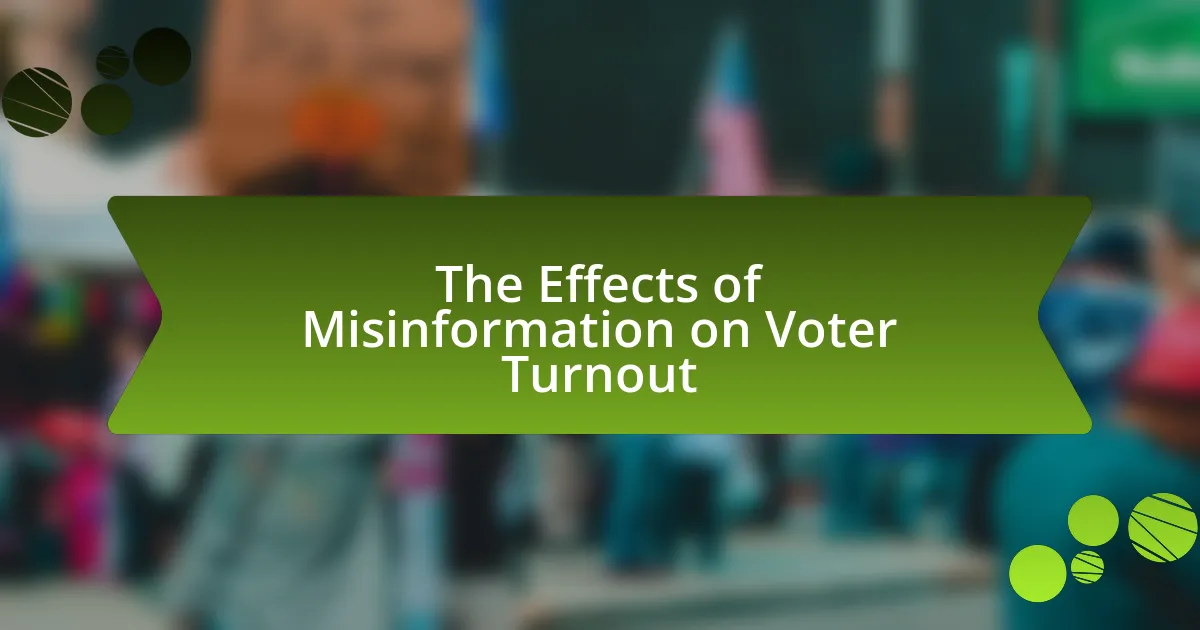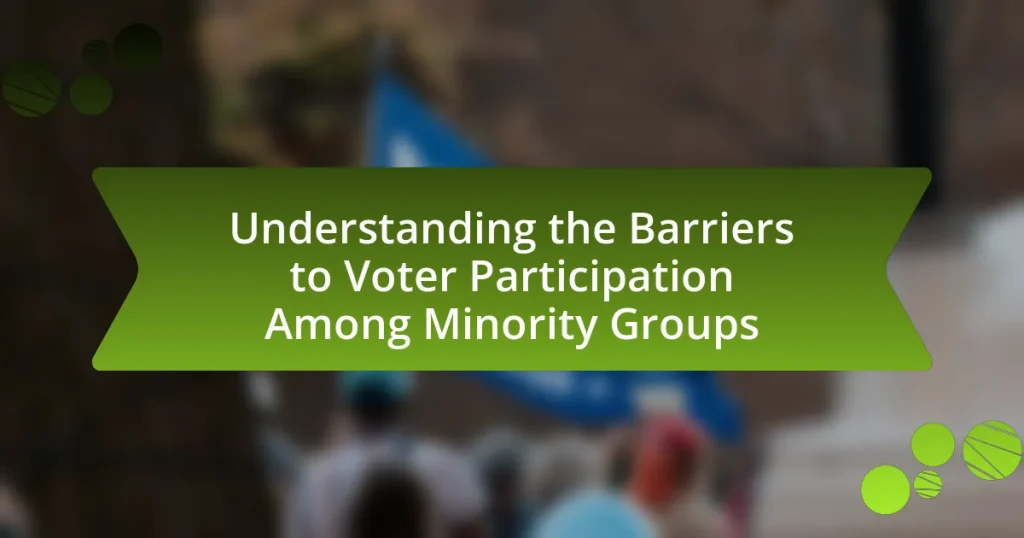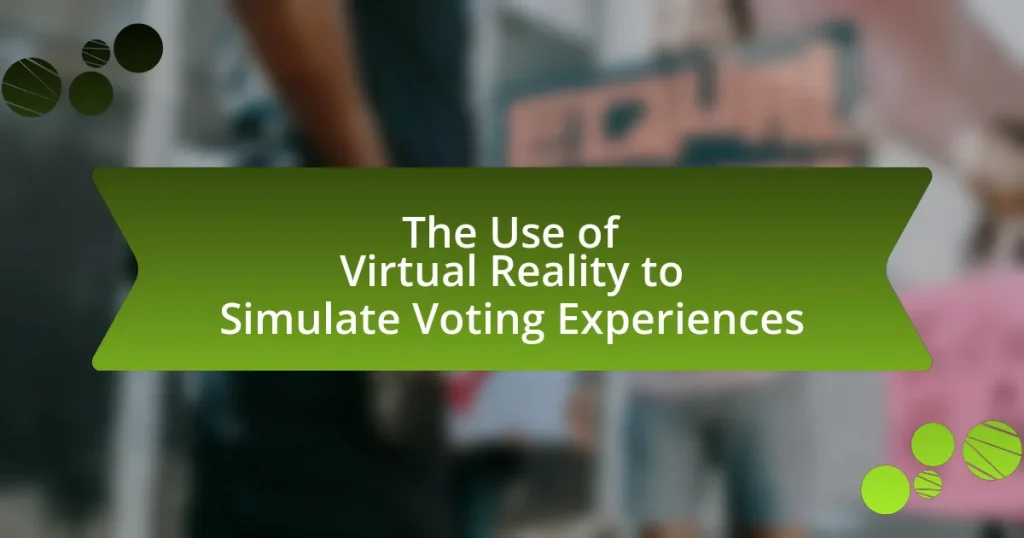The article examines the effects of misinformation on voter turnout, highlighting how false information creates confusion and distrust among potential voters. It discusses the various types of misinformation prevalent during elections, including misleading claims about candidates and incorrect voting procedures, which can significantly impact voter perceptions and confidence in the electoral process. The article also explores demographic variations in susceptibility to misinformation, emphasizing its disproportionate effects on younger voters and marginalized populations. Additionally, it outlines strategies to mitigate misinformation’s impact, such as media literacy programs and community engagement initiatives, while providing resources for voters to verify information and make informed decisions.
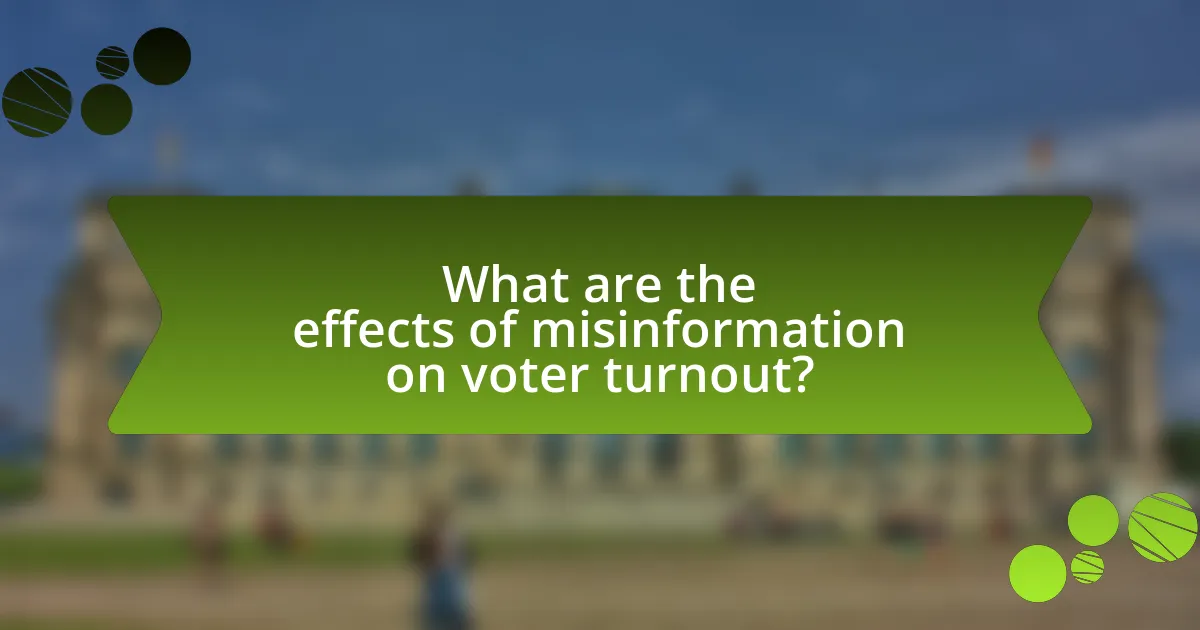
What are the effects of misinformation on voter turnout?
Misinformation negatively impacts voter turnout by creating confusion and distrust among potential voters. Studies indicate that exposure to false information can lead to decreased motivation to participate in elections, as individuals may feel uncertain about the voting process or the legitimacy of candidates. For instance, a report by the Pew Research Center found that 64% of Americans believe misinformation affects their understanding of political issues, which can discourage them from voting. Furthermore, misinformation can lead to the spread of incorrect voting information, such as false polling dates or eligibility requirements, further deterring individuals from casting their ballots.
How does misinformation influence voter perceptions?
Misinformation significantly influences voter perceptions by shaping beliefs and attitudes about candidates and issues. Studies indicate that exposure to false information can lead to distorted views, such as increased distrust in political institutions and altered opinions on policy matters. For instance, research published in the journal “Political Communication” by Lewandowsky et al. (2012) demonstrates that misinformation can persist in public discourse, affecting how voters evaluate candidates and their platforms. This distortion can ultimately impact voter turnout, as individuals may feel disillusioned or misinformed about the electoral process.
What types of misinformation are most prevalent during elections?
The most prevalent types of misinformation during elections include false claims about candidates, misleading information regarding voting procedures, and fabricated statistics about voter turnout. False claims about candidates often involve distorted facts about their policies or personal lives, which can significantly influence public perception and voter decisions. Misleading information regarding voting procedures, such as incorrect dates or methods of voting, can lead to voter confusion and decreased turnout. Additionally, fabricated statistics about voter turnout can create a false narrative about the election’s legitimacy, further impacting voter engagement. Research by the Pew Research Center indicates that 64% of Americans believe misinformation has a significant impact on the electoral process, highlighting the critical nature of these misinformation types.
How does misinformation affect voter confidence in the electoral process?
Misinformation significantly undermines voter confidence in the electoral process by creating doubt about the integrity and reliability of elections. Studies indicate that exposure to false information can lead to decreased trust in electoral institutions, as voters may question the legitimacy of the outcomes and the processes involved. For instance, a 2020 survey by the Pew Research Center found that 70% of Americans believed misinformation had a major impact on public confidence in elections. This erosion of trust can result in lower voter turnout, as individuals may feel disillusioned or skeptical about the effectiveness of their participation in the democratic process.
Why is understanding misinformation important for voter engagement?
Understanding misinformation is crucial for voter engagement because it directly influences voters’ perceptions and decisions. Misinformation can lead to confusion about voting processes, candidate positions, and critical election dates, ultimately discouraging participation. For instance, a study by the Pew Research Center found that 64% of Americans believe misinformation has a significant impact on their understanding of political issues. This highlights the need for voters to critically assess information sources to make informed choices, thereby enhancing overall electoral participation and democratic processes.
What role does social media play in spreading misinformation?
Social media significantly contributes to the spread of misinformation by facilitating rapid dissemination and amplifying false narratives. Platforms like Facebook and Twitter allow users to share content widely, often without verification, leading to the viral spread of misleading information. A study by the Massachusetts Institute of Technology found that false news stories are 70% more likely to be retweeted than true stories, highlighting the platform’s role in amplifying misinformation. Additionally, algorithms prioritize engaging content, which often includes sensational or misleading information, further exacerbating the issue.
How can misinformation lead to voter apathy or disengagement?
Misinformation can lead to voter apathy or disengagement by creating confusion and distrust in the electoral process. When voters encounter false information about candidates, policies, or voting procedures, they may feel overwhelmed and uncertain about their ability to make informed decisions. This confusion can result in a lack of motivation to participate in elections, as individuals may believe their votes do not matter or that the system is rigged. Research from the Pew Research Center indicates that 64% of Americans believe misinformation has a significant impact on public opinion, which can further discourage voter engagement.
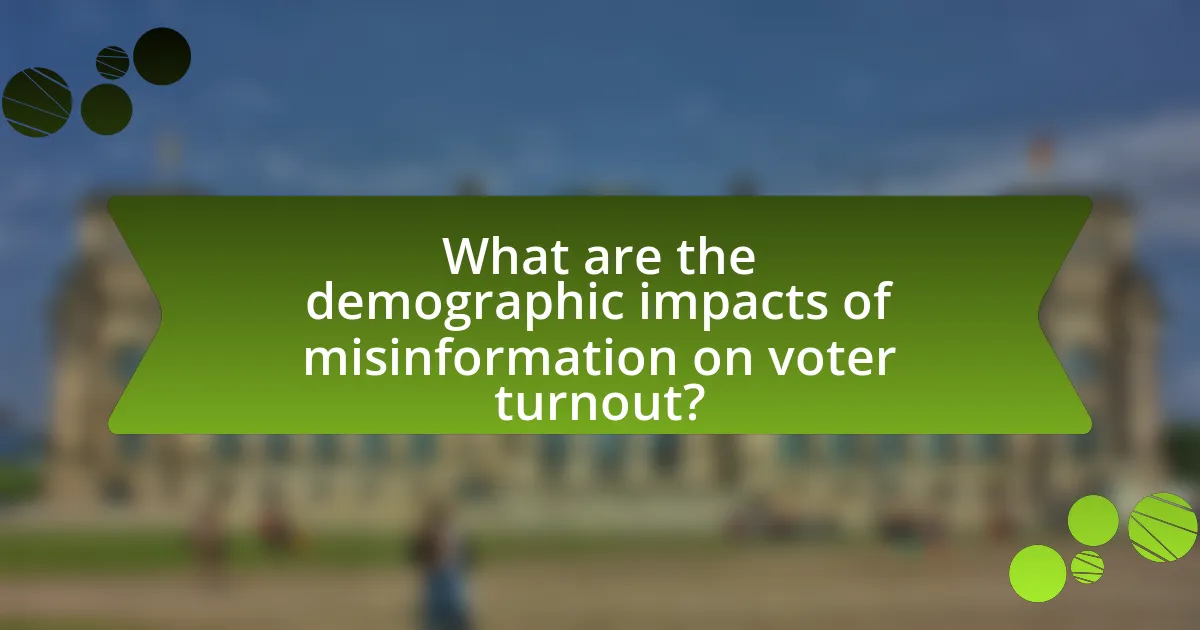
What are the demographic impacts of misinformation on voter turnout?
Misinformation significantly impacts voter turnout across various demographic groups, often leading to decreased participation among marginalized populations. Research indicates that misinformation disproportionately affects younger voters, racial minorities, and low-income individuals, who may lack access to reliable information sources. For instance, a study by the Pew Research Center found that 64% of Americans believe misinformation has a major impact on their understanding of political issues, with younger voters being more susceptible to false information shared on social media platforms. This demographic is often less engaged in traditional news outlets, making them more reliant on potentially misleading online content. Consequently, misinformation can exacerbate existing disparities in voter turnout, as these groups may become disillusioned or confused about the voting process, leading to lower participation rates.
How does misinformation affect different age groups?
Misinformation affects different age groups in distinct ways, primarily due to varying levels of media literacy and technology use. Younger individuals, often more engaged with social media, may encounter misinformation more frequently, leading to confusion and misinformed opinions about political issues. For instance, a study by the Pew Research Center found that 64% of Americans aged 18-29 reported encountering false information online, which can skew their perceptions and influence their voting behavior. In contrast, older adults, who may rely more on traditional media, are also susceptible to misinformation but often have a greater ability to critically evaluate sources. However, they can be targeted by misinformation campaigns that exploit their trust in established media outlets. Research indicates that 70% of adults over 65 have encountered misleading information, which can lead to decreased voter turnout as they may feel overwhelmed or distrustful of the electoral process. Thus, misinformation impacts younger and older voters differently, shaping their engagement and decisions in the political landscape.
What specific challenges do younger voters face regarding misinformation?
Younger voters face significant challenges regarding misinformation, primarily due to their reliance on social media as a primary news source. This demographic is particularly susceptible to false information because platforms like Facebook and Twitter often prioritize engagement over accuracy, leading to the rapid spread of misleading content. According to a study by the Pew Research Center, 64% of Americans aged 18 to 29 report that they get their news from social media, which is often rife with unverified claims and sensationalism. Additionally, younger voters may lack the experience or critical thinking skills necessary to discern credible sources from unreliable ones, further exacerbating their vulnerability to misinformation.
How do older voters respond to misinformation compared to younger voters?
Older voters tend to be more susceptible to misinformation compared to younger voters. Research indicates that older adults often have a higher level of trust in traditional media sources, which can lead them to accept misleading information without critical scrutiny. A study published in the journal “Political Behavior” by Guess, Nagler, and Tucker (2020) found that older individuals are more likely to share false information on social media, demonstrating a greater vulnerability to misinformation. In contrast, younger voters, who are generally more adept at navigating digital platforms and discerning credible sources, exhibit a lower likelihood of being influenced by false narratives. This difference in response to misinformation can significantly impact voter turnout, as older voters may be swayed by misleading claims that affect their perceptions of candidates and issues.
What are the geographic variations in the effects of misinformation?
Geographic variations in the effects of misinformation significantly influence voter turnout across different regions. For instance, studies indicate that misinformation tends to have a more pronounced impact in areas with lower media literacy and higher social media usage, such as rural regions in the United States. Research by the Pew Research Center shows that misinformation can lead to decreased voter turnout by creating confusion about voting procedures, particularly in states with strict voter ID laws. Additionally, regions with diverse populations may experience varying susceptibility to misinformation based on cultural and linguistic factors, affecting how messages are received and interpreted.
How does misinformation impact urban versus rural voters?
Misinformation impacts urban and rural voters differently, primarily due to variations in access to information and social networks. Urban voters often have greater access to diverse media sources and fact-checking resources, which can mitigate the effects of misinformation. In contrast, rural voters may rely more on local news and social media, where misinformation can spread more easily and go unchecked. A study by the Pew Research Center found that rural Americans are more likely to encounter misinformation on social media platforms, leading to increased polarization and misinformed voting decisions. This disparity highlights the need for targeted interventions to combat misinformation in both urban and rural contexts.
What regional differences exist in susceptibility to misinformation?
Regional differences in susceptibility to misinformation are influenced by factors such as media literacy, political polarization, and cultural context. For instance, studies indicate that regions with lower media literacy, such as parts of the United States and Eastern Europe, show higher susceptibility to misinformation, as individuals may lack the skills to critically evaluate information sources. Additionally, areas with high political polarization, like the United States, often experience increased vulnerability to misinformation that aligns with partisan beliefs, leading to greater acceptance of false narratives. Research by the Pew Research Center highlights that individuals in politically divided regions are more likely to encounter and believe misinformation that supports their views, demonstrating a clear link between regional characteristics and susceptibility to misinformation.
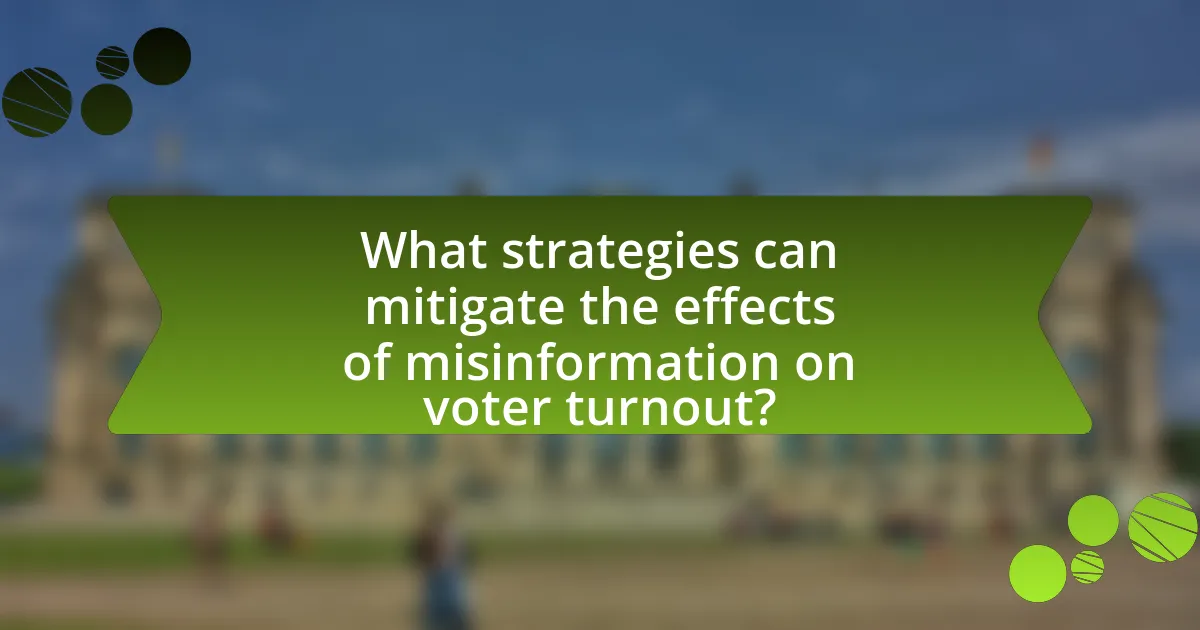
What strategies can mitigate the effects of misinformation on voter turnout?
To mitigate the effects of misinformation on voter turnout, implementing comprehensive media literacy programs is essential. These programs educate voters on how to critically evaluate information sources, recognize misinformation, and verify facts before sharing or acting on them. Research indicates that individuals exposed to media literacy training are more likely to discern credible information from falsehoods, thereby reducing the likelihood of misinformation influencing their voting behavior. For instance, a study by the Stanford History Education Group found that students who received media literacy instruction improved their ability to identify misleading information online. Additionally, collaboration between social media platforms and fact-checking organizations can help flag and correct false information in real-time, further protecting voters from being misled.
How can education and awareness campaigns combat misinformation?
Education and awareness campaigns can effectively combat misinformation by equipping individuals with critical thinking skills and accurate information. These campaigns promote media literacy, enabling people to discern credible sources from unreliable ones. For instance, a study by the Stanford History Education Group found that students who received instruction on evaluating online information were significantly better at identifying misinformation compared to those who did not receive such training. By fostering an informed electorate, education and awareness initiatives can reduce the impact of false information on voter turnout, ultimately leading to more informed decision-making during elections.
What are effective methods for educating voters about misinformation?
Effective methods for educating voters about misinformation include implementing comprehensive media literacy programs, utilizing fact-checking resources, and promoting community engagement initiatives. Media literacy programs equip voters with critical thinking skills to analyze and evaluate information sources, which is essential in combating misinformation. Research indicates that individuals who participate in media literacy training are better at identifying false information (Hobbs, 2017). Fact-checking resources, such as websites like Snopes and FactCheck.org, provide accessible verification of claims, helping voters discern factual content from misleading narratives. Additionally, community engagement initiatives, such as workshops and town hall meetings, foster discussions around misinformation, allowing voters to share experiences and learn collectively. These methods collectively enhance voter awareness and resilience against misinformation, ultimately supporting informed electoral participation.
How can community organizations play a role in reducing misinformation?
Community organizations can play a crucial role in reducing misinformation by actively engaging in educational initiatives that promote media literacy and critical thinking among the public. These organizations often have established trust within their communities, allowing them to effectively disseminate accurate information and counter false narratives. For instance, a study by the Pew Research Center found that community-based interventions can significantly improve individuals’ ability to discern credible sources from unreliable ones, thereby reducing the spread of misinformation. By hosting workshops, providing resources, and utilizing social media platforms, community organizations can empower citizens to verify information before sharing it, ultimately fostering a more informed electorate and enhancing voter turnout.
What tools and resources are available to help voters verify information?
Voters can utilize several tools and resources to verify information, including fact-checking websites, official election office resources, and voter education platforms. Fact-checking websites like Snopes and FactCheck.org provide evidence-based assessments of claims related to elections and candidates. Official election office resources, such as state or local election websites, offer accurate information about voting procedures, candidate qualifications, and ballot measures. Additionally, voter education platforms like Vote.org and Ballotpedia provide comprehensive information on voting rights, registration, and election dates, helping voters make informed decisions. These resources collectively enhance voter awareness and combat misinformation, thereby supporting informed voter turnout.
How can technology be leveraged to counter misinformation?
Technology can be leveraged to counter misinformation through the development of advanced algorithms and platforms that identify and flag false information. For instance, social media companies utilize machine learning algorithms to detect patterns associated with misinformation, allowing them to automatically flag or remove misleading content. A study by the Pew Research Center found that 64% of Americans believe that social media platforms should take more responsibility for preventing the spread of false information. Additionally, fact-checking organizations employ technology to verify claims in real-time, providing users with accurate information and context. This combination of automated detection and human oversight enhances the reliability of information available to voters, ultimately reducing the impact of misinformation on voter turnout.
What best practices should voters follow to ensure they are informed?
Voters should follow several best practices to ensure they are informed, including researching candidates and issues from multiple reliable sources, verifying information before sharing, and participating in community discussions. Researching candidates involves reviewing their platforms, past performance, and public statements, which can be found on official campaign websites and reputable news outlets. Verifying information helps combat misinformation; for instance, fact-checking websites like Snopes or FactCheck.org provide accurate assessments of claims. Engaging in community discussions allows voters to hear diverse perspectives and clarify doubts, fostering a more informed electorate. These practices are essential in countering the effects of misinformation on voter turnout, as studies show that informed voters are more likely to participate in elections and make decisions based on facts rather than falsehoods.
